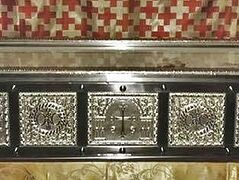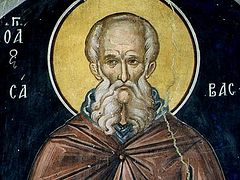The final twenty years of St. Sabbas’s life were adorned with other amazing works [besides the founding of monasteries and raising monastics in the spiritual life], which had enormous significance for ecclesiastical as well as general history. Under pressure from the followers of the Monophysite Emperor Anastasios (491–518) and the Monophysite “Acephali” Severus, Philoxenus, and Sotirichus, the Orthodox Church in the East gradually went over to the Monophysite bishops. At the insistence of Elias, the Orthodox patriarch of Jerusalem (494–516), in 512 St. Sabbas arrived in Constantinople where he convinced the emperor not to send Elias into exile, making use of his authority and lofty reputation. When the next year the emperor again decided to exile the Orthodox hierarch, St. Sabbas convened in Jerusalem all the anchoretic monks in order to defend Elias, and anathematized the emperor’s heretical emissaries. Likewise, with the support of St. Theodosius the Coenobiarch, the anchorites gathered again three years later in 516 A. D. in order to strengthen Patriarch John III (516–524) in the Orthodox faith. This unanimous representation helped keep the Jerusalem Church in Orthodoxy, while the Constantinople, Alexandria, and Antiochean Churches had gone over to the Monophysite patriarchs. Not long later, Orthodoxy was restored everywhere.
St. Sabbas’s further venerable life. His meeting with Justinian in Constantinople. The saint’s repose (516–532).
St. Sabbas’s second arrival in the imperial city took place twenty years after the first one, in 530 A.D, when the saint was ninety years old. Then Sabbas was able to free Palestine from the cruel measures that Justinian wanted to take after the disorders following the rebellion of the Samaritans and Jews (529). Furthermore, the saint persuaded the pious emperor, to whom Sabbas’s sanctity had been revealed in a vision, to take measures against the heresies of Arius, Nestorius, and Origen and other measures beneficial to Palestine. For this Sabbas promised that the emperor’s power would stretch over Africa and Italy. And truly, St. Sabbas’s blessing and prophecy were fulfilled: The victory of the generals Velizarios and Narsesos returned the western parts of the empire to the authority of Constantinople. Such was St. Sabbas’s gift of prophecy.
We could tell of so many miracles of the saint that it is difficult to decide which of his miracles are most worthy of admiration. He was gifted with such great grace that his prayers saved Jerusalem from a five-year drought that came after the unjust exile of Patriarch Elias, which had brought God’s wrath upon the city (520). His return from the imperial city also marked the beginning of the end of his life. Our holy father Sabbas the Sanctified departed to the Lord after his earthly labors on December 5, 532 A.D. He lived in the Flavian coenobium for ten years until the age of eighteen, for seventeen years he lived in the coenobium of St. Theoktistos in Palestine, and fifty-nine years in various deserts and in the Great Lavra. In around 547 his honorable remains were found whole and incorrupt in his tomb. Many centuries later they were taken to Constantinople, and from there the Crusaders in 1204 took them to Venice. In 1965 the saints’ relics were returned forever to his Great Lavra. His Life was first written for the faithful by Cyril of Scythopolis in around 557 A.D.
According to the true words of our Lord Jesus Christ, a man is known by his fruits (cf. Mt. 7:20; Lk. 6:43). Therefore the further growth of the Great Sanctified Lavra of St. Sabbas is the fruit of the saint’s divine fruit, a testimony to his glory, his boldness and closeness to God. This is why this very important monastic community remains to this day in the Judean desert. Truly astounding are not only his innumerable miracles, but also their reflection in the life of his Lavra, which has become an example to other monasteries and has had a profound influence on the monastic life and rule of divine services throughout the Orthodox Church. Furthermore, the Lavra raised a multitude of holy men both canonized and unknown, amongst whom of particular fame are the great eighth century theologian, St. John Damascene. Veneration for St. Sabbas quickly spread from Rome to Georgia in the Caucasus. The abbots who were successors to the saint made the Lavra a stronghold of Orthodoxy in Palestine against Origenism, Monothelytism, iconoclasm, and papism, before the face of the entire Orthodox world. When the medieval age had passed, the Lavra was still the school of the Brotherhood of the Holy Sepulcher, whose members received their initial preparation for monastic life and experience in church affairs in the Lavra. All of this took place thanks to the authority and example of St. Sabbas. “Brilliant and God-inspired were the works of our sanctified father Sabbas: His manner of life was glorious, his life was virtuous, and his faith was Orthodox. This was mentioned in part above.”1
Holy Father Sabbas the Sanctified, prayer to God for us in these complicated times!
From The Holy Lavra of Saint Sabbas. A Stronghold of Eastern Orthodox Christianity Created by God (Publishing house of the Holy Lavra of Saint Sabbas). (Used with permission.)




